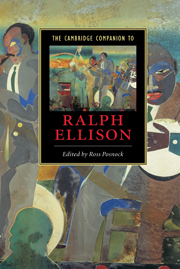Book contents
- Frontmatter
- Introduction
- 1 Ralph Ellison’s invented life
- 2 Ellison and the black Church
- 3 Ellison, photography, and the origins of invisibility
- 4 Ralph Ellison’s music lessons
- 5 Ralph Ellison’s constitutional faith
- 6 Ralph Ellison and the politics of melancholia
- 7 Invisible Ellison
- 8 Ellison’s experimental attitude and the technologies of illumination
- 9 Female iconography in Invisible Man
- 10 Chaos not quite controlled
- 11 Ralph Ellison, Hannah Arendt, and the meaning of politics
- 12 Dry bones
- Selected bibliography and suggestions for further reading
- Index
- Series List
10 - Chaos not quite controlled
Ellison’s uncompleted transit to Juneteenth
Published online by Cambridge University Press: 28 May 2006
- Frontmatter
- Introduction
- 1 Ralph Ellison’s invented life
- 2 Ellison and the black Church
- 3 Ellison, photography, and the origins of invisibility
- 4 Ralph Ellison’s music lessons
- 5 Ralph Ellison’s constitutional faith
- 6 Ralph Ellison and the politics of melancholia
- 7 Invisible Ellison
- 8 Ellison’s experimental attitude and the technologies of illumination
- 9 Female iconography in Invisible Man
- 10 Chaos not quite controlled
- 11 Ralph Ellison, Hannah Arendt, and the meaning of politics
- 12 Dry bones
- Selected bibliography and suggestions for further reading
- Index
- Series List
Summary
One of the stranger documents among Ralph Ellison's published works is the essay ''Tell It Like It Is, Baby,'' which he began writing while in Rome in 1956 but left uncompleted for almost a decade until he published it in the centenary issue of The Nation in 1965. What prompted the essay was a letter to Ellison from a boyhood friend, Virgil Branam, who had written to express outrage at the defiance of southern senators in the face of the US Supreme Court's Brown v. Board of Education ruling. In March of 1956 twenty-two US senators from southern states, led by Strom Thurmond of South Carolina, signed and circulated a ''Southern Manifesto,'' in which, among other things, they embraced Plessy v. Ferguson with the claim that the 1896 ruling had become ''a part of the life of the people of many of the States and confirmed their habits, traditions, and way of life.'' The manifesto concluded with the senators vowing to reverse the decision of the US Supreme Court in Brown. Troubled by this open defiance, Branam, one of Ellison's long-time correspondents, wanted to know what sense the famous novelist could make of the events roiling the American scene.
- Type
- Chapter
- Information
- The Cambridge Companion to Ralph Ellison , pp. 188 - 200Publisher: Cambridge University PressPrint publication year: 2005
- 2
- Cited by

